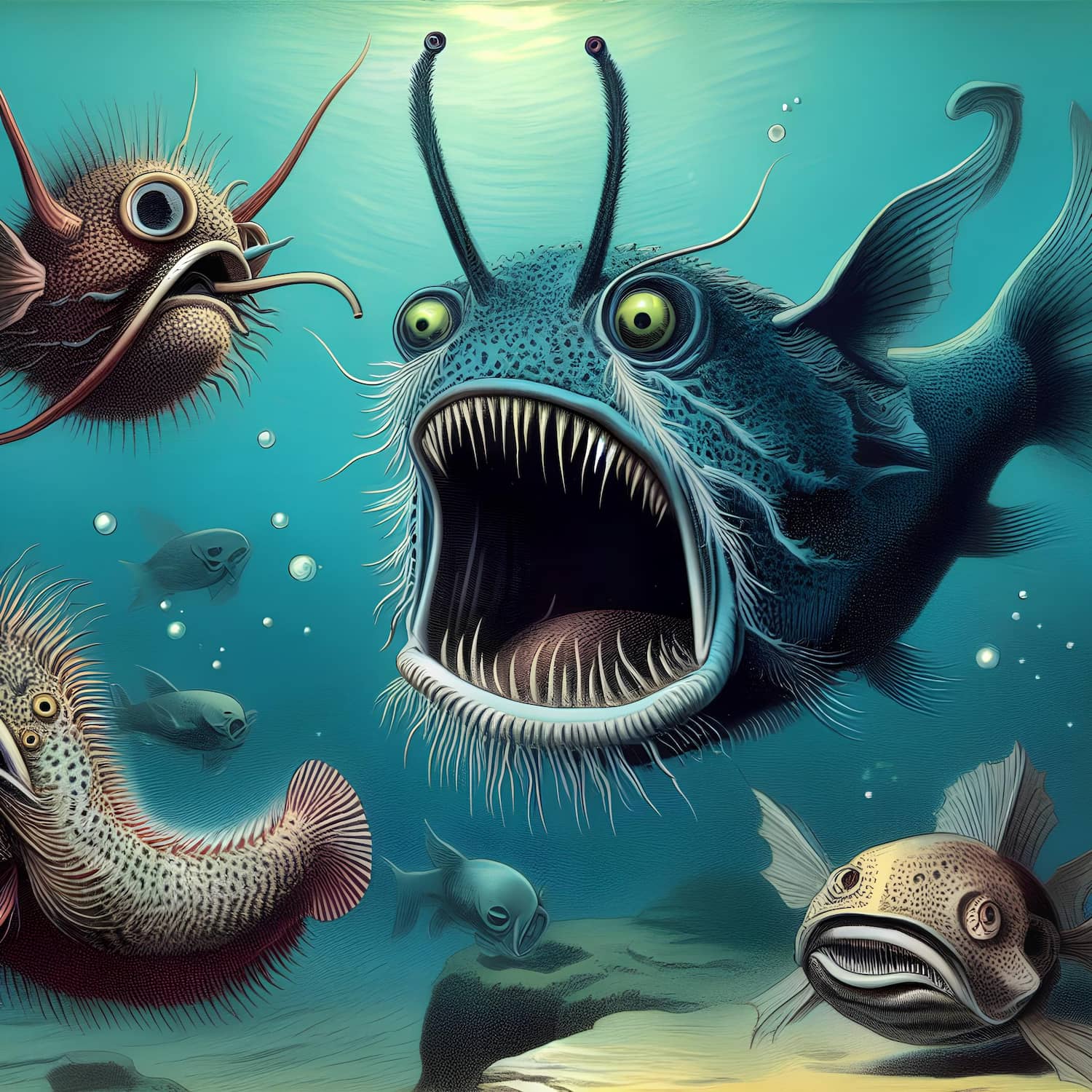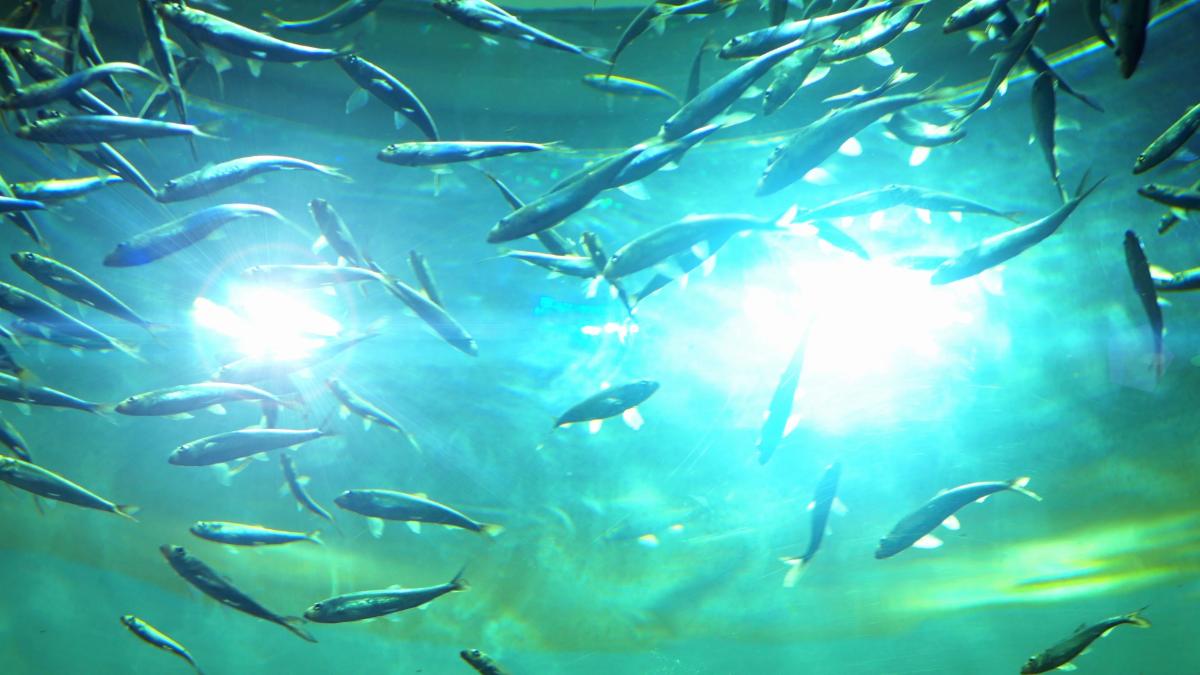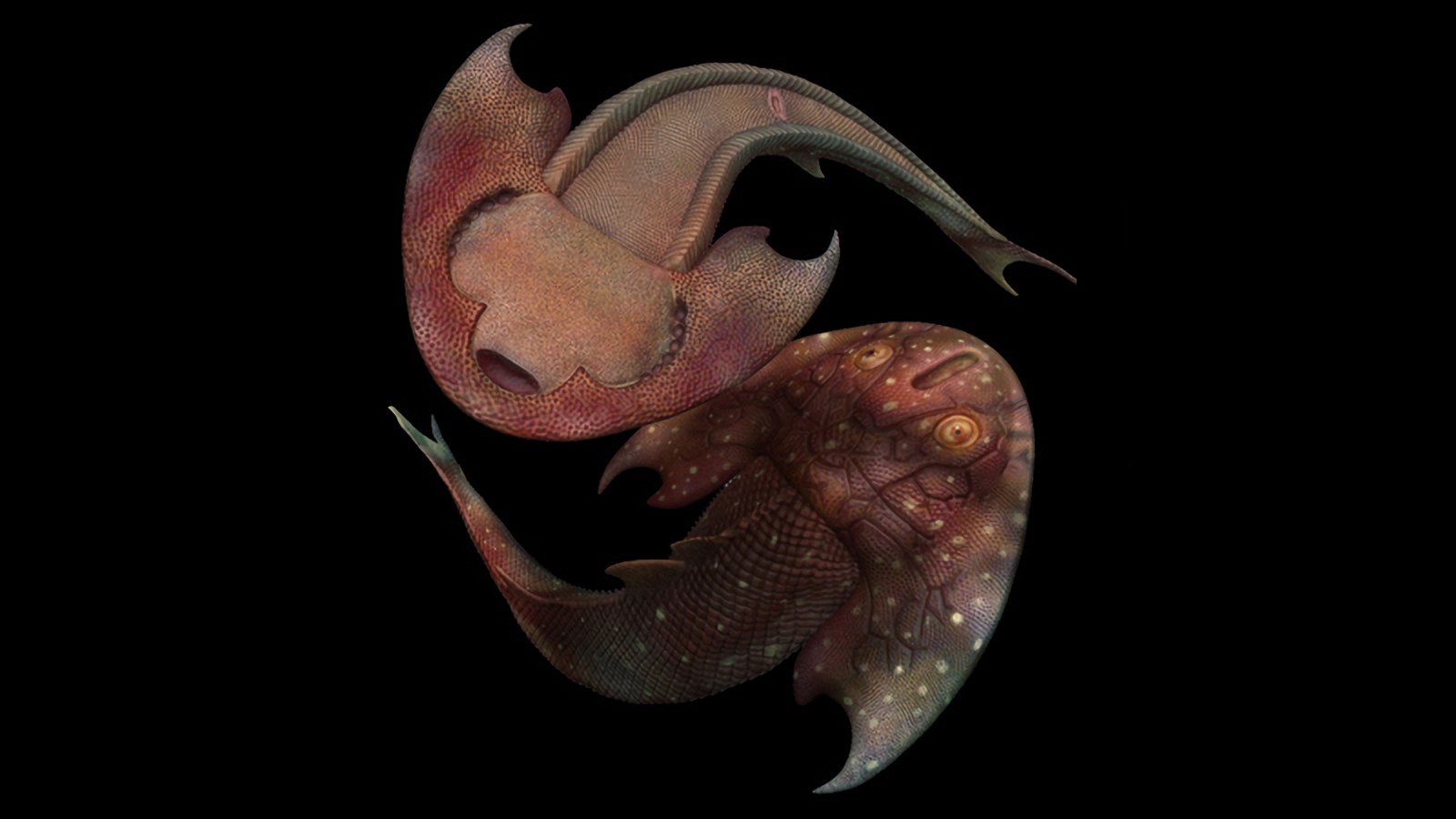It was long thought that life in the abyss was impossible. Today, we know that there are a number of fish that live there. Strictly speaking, abyssal fauna is the set of animals living in this oceanic zone, that is, living between 4,000 and 6,000 (13,000–20,000 ft) meters deep. The deepest point in the ocean is 10,912 meters. Men have successfully descended six times to the deepest point of the ocean, in the Mariana Trench east of the Philippines. They have dived to depths of almost 11,000 meters.
Weirdest Deep Sea Creatures
Anglerfish
These eerie-looking fish have a bioluminescent lure that dangles in front of their mouths, attracting prey in the dark depths of the ocean. The anglerfish is one of the most famous deep-sea fish. It is also one of the most atypical. This creature is both a fish and a fisherman. It has an almost infallible technique for fishing. This fish was seen in the animated film “Finding Nemo.” The anglerfish can live up to 2,000 meters deep.
- Physical Structure: Small, stocky fish with a bioluminescent lure.
- Unique Characteristics: The lure attracts prey towards its sharp teeth.
Gulper Eel (Pelican Eel)
The pelican grangousier is a fish that has eyes (and a mouth) bigger than its stomach. It is known to be able to eat prey larger than itself. Its mouth is disproportionate to its body, which resembles that of an eel. Pelican grangousiers measure between 40 centimeters and 2 meters in length.
- Physical Structure: Elongated body with a massive mouth.
- Unique Characteristics: It can swallow prey larger than itself due to its expandable stomach.
Vampire Squid
The Vampire Squid, or Vampyroteuthis infernalis, is a species of small cephalopod that lives in the abysses of all the world’s temperate and tropical oceans. Its unique retractile sensory filaments justify its placement in a specific order: Vampyromorphida, although it shares similarities with squid and octopus.
Despite its monstrous physiognomy, the vampire squid only reaches 30 cm (12 in) in adult length. It poses no threat to humans. Its gelatinous coat varies from velvety black to pale red, depending on location and lighting conditions. A membrane of skin links its eight arms, each lined with rows of fleshy or pointed spines.
The vampire squid is entirely covered with light-producing organs called photophores. The animal has great control over these organs, capable of producing flashes of light every fraction of a second for several minutes to disorient predators.
- Physical Structure: Long, slender body with sharp teeth.
- Unique Characteristics: Bioluminescent lure and a distensible stomach.
Barreleye Fish
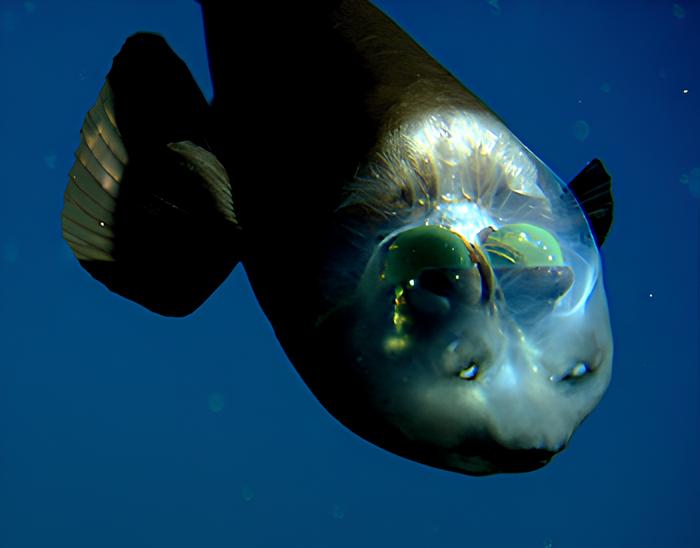
The Macropinna microstoma, also known as the barreleye fish in English, is a species of fish belonging to the Opisthoproctidae family in the North Pacific. It is the only species in its genus Macropinna.
This fish possesses a truly unique ocular system. Its two large tubular eyes are shielded within its skull by a greenish filter, giving it a ghostly appearance. These eyes observe the fish’s surroundings through its completely transparent (at its upper part) skull.
The Macropinna microstoma has a small mouth and is covered in large scales throughout its body. Its size is around 15 cm, including its tail.
This fish has been found at depths ranging from 500 (1650 ft) to 1,000 meters (3280 ft). It has been filmed at a depth of approximately 600 (2,000 ft) to 800 meters (2,600 ft) in its natural habitat off the coast of California. It is believed that its unique eyes allow the fish to detect small prey by their silhouettes in low light from above or to detect prey emitting light.
- Physical Structure: Transparent head with upward-looking eyes.
- Unique Characteristics: Has a transparent shield over its head.
Dumbo Octopus
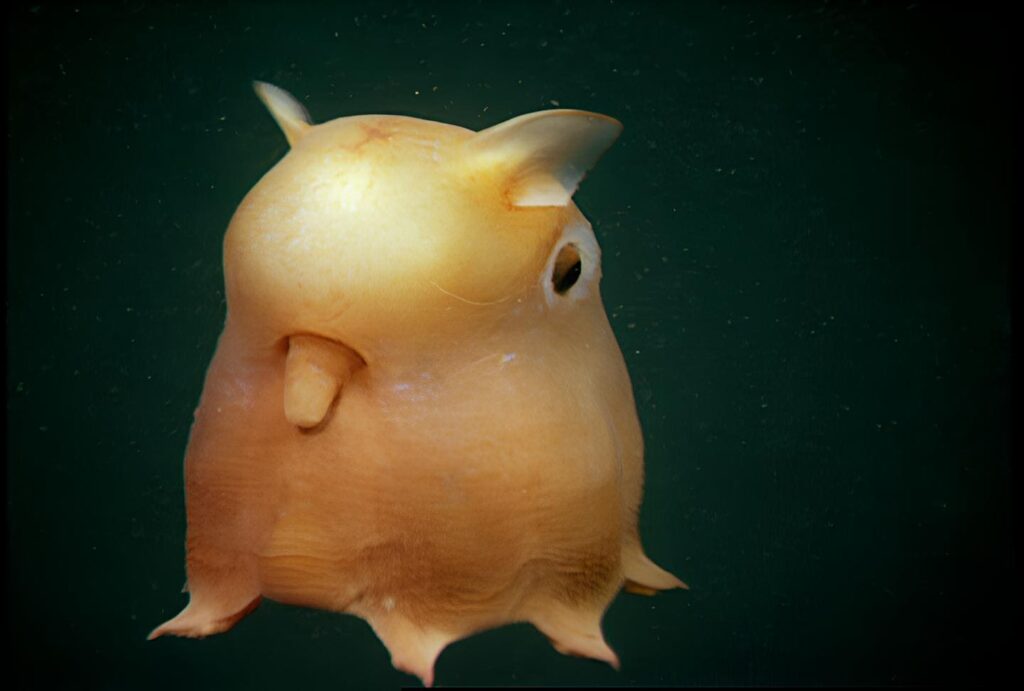
The Grimpoteuthis, also known as the Dumbo octopus, is a species of octopus that lives in the extreme depths of the ocean, between 400 and 4800 meters (13,000 ft), and some even survive at depths of 7000 meters (23,000 ft) below sea level. They are found worldwide, including off the coasts of New Zealand, Australia, California, Oregon, the Philippines, New Guinea, and Martha’s Vineyard, Massachusetts.
These creatures are small, measuring about 20 centimeters (8 in) in height, although one specimen was observed measuring 1.8 meters in length and weighing 5.9 kilograms. They have a pair of fins located on their mantle (hence their name) and a membrane between their arms. Grimpoteuthis often swims just above the seafloor in search of snails, worms, and other prey.
The Grimpoteuthis has surprisingly large eyes that fill about one-third of the diameter of their mantle or “head,” but their eyes have limited use in the eternal darkness of the deep. In some species, the eye lacks a lens and has a degraded retina, likely allowing only the detection of light, darkness, and movement.
- Physical Structure: Small, rounded body with ear-like fins.
- Unique Characteristics: Uses ear-like fins for movement and to steer.
Blobfish
The blobfish, Psychrolutes marcidus, belongs to the Psychrolutidae family. It primarily inhabits the waters off Tasmania and Australia, in the deep-sea regions beyond 600 meters in depth, reaching depths of around 1,200 meters. It is not suitable for human consumption. Therefore, there is little chance of encountering this abyssal fish.
It is a rather solitary creature. Encounters between males and females mostly occur during the breeding season. However, the blobfish still holds many mysteries in this regard, as specialists who have observed it on various occasions don’t know much more about it today.
A female blobfish lays a minimum of 1,000 eggs, but scientists who studied blobfish reproduction in 2000 for the first time specify that some females can lay up to 100,000 eggs. The eggs are extremely lightweight. They gather into a kind of pink floating mass just above the seafloor during the incubation period, and the female constantly cleans them.
- Physical Structure: Gelatinous and somewhat amorphous.
- Unique Characteristics: Appears strange due to its gel-like consistency.
Fangtooth Fish
The fangtooth fish (Anoplogaster cornuta) is a species of deep-sea fish belonging to the Anoplogastridae family. It thrives in an extremely hostile environment with limited food sources, residing at depths ranging from 500 (1600 ft) to 5,000 meters (16,000 ft). Due to the scarcity of food at these depths, the fangtooth fish must be capable of eating nearly anything it comes across.
Proportionally to its size, it possesses the largest teeth of any animal in the world. It cannot even fully close its jaws. Unlike other species inhabiting the deep sea, it is powerful and robust, serving as a small but mighty predator.
Despite their very large teeth, fangtooth fish are small in size, rarely exceeding 18 cm (7 in) in length. Moreover, there is very little chance of encountering them while swimming, as these fish inhabit extremely deep waters.
- Physical Structure: Small fish with disproportionately large, sharp teeth.
- Unique Characteristics: Its teeth are so large that it can’t close its mouth completely.
Deep-sea Dragonfish
The Deep-sea Dragonfish, also known as Stomiidae, is a family of teleost fish that inhabit the deep abysses of the ocean. These fish live in the darkest, most inaccessible parts of the ocean, where there is almost no natural light. They are well-suited to this extreme environment.
One of their most fascinating features is their ability to produce bioluminescent light. They use this light to attract prey, primarily smaller fish and invertebrates, which are drawn to the dragonfish’s glow.
Deep-sea dragonfish have the remarkable ability to camouflage themselves. They can emit a faint red light to blend in with the background light from the surface. This makes them nearly invisible to both their prey and potential predators.
They possess large, hinged jaws that are equipped with numerous sharp, fang-like teeth. These jaws allow them to capture and devour prey of various sizes. Deep-sea dragonfish come in various sizes, with some species growing up to around 6 inches (15 centimeters) in length.
Little is known about their reproductive habits, but they are believed to follow the typical teleost fish reproductive patterns. Some deep-sea dragonfish are known to exhibit sexual dimorphism, where males and females have different physical characteristics.
- Physical Structure: Long, slender body with sharp teeth.
- Unique Characteristics: Bioluminescent lure and a distensible stomach.
Marine Hatchetfish
Marine Hatchetfish are found in the deep waters of the world’s oceans, primarily in the mesopelagic and bathypelagic zones. These fish have specialized light-producing organs called photophores. They use bioluminescence to emit light, which helps them camouflage and attract prey. This adaptation is essential for survival in the pitch-black depths of the ocean.
Marine Hatchetfish are named for their distinctive body shape, resembling a hatchet or an axe. They have flattened bodies and are relatively small, typically measuring around 2 to 5 inches (5 to 13 centimeters) in length. Their silver-colored bodies are equipped with photophores along their belly, which they use to blend in with the faint light from above. This countershading adaptation makes them less visible to predators swimming below and prey swimming above.
Like many deep-sea creatures, Marine Hatchetfish exhibit vertical migration. They move closer to the surface at night to feed on zooplankton and retreat to deeper waters during the day to avoid predators.
These fish are opportunistic feeders and voracious predators. They primarily consume small crustaceans, copepods, and other small organisms. Their upward-facing mouths make them adept at capturing prey from below.
- Physical Structure: Distinct hatchet-like shape.
- Unique Characteristics: Photophores for bioluminescence.
Giant Tube Worms
Giant Tube Worms, also known as Riftia pachyptila, are deep-sea creatures that thrive in extreme hydrothermal vent environments. Giant Tube Worms are primarily found in deep-sea hydrothermal vent ecosystems along mid-ocean ridges, which are some of the most extreme and least explored environments on Earth.
These tube worms engage in a unique and mutually beneficial symbiotic relationship with chemosynthetic bacteria. The bacteria live within their bodies and provide them with essential nutrients in exchange for chemicals from the hydrothermal fluids.
Giant Tube Worms have evolved remarkable adaptations to survive in these extreme conditions, including high temperatures, high pressure, and complete darkness. They can tolerate temperatures exceeding 200 degrees Celsius (392 degrees Fahrenheit). They create long, tube-like structures that can reach lengths of several feet. The tube is made of a tough, durable material that protects them from harsh surroundings.
Giant Tube Worms do not have a mouth or a digestive system like most organisms. Instead, they rely entirely on the chemosynthetic bacteria living in their trophosome (a specialized organ) to convert chemicals from the hydrothermal vent fluids into organic compounds they can use for sustenance.
These creatures are extremely long-lived compared to many other deep-sea organisms. They can live for decades, potentially reaching up to 100 years or more. They also play a role in nutrient cycling in deep-sea ecosystems. They contribute to the overall biodiversity of hydrothermal vent communities, which are now recognized as critical habitats.
Although they are adapted to extreme conditions, the discovery of deep-sea mining operations in hydrothermal vent areas has raised concerns about the potential impact on these unique creatures and their ecosystems.
- Physical Structure: Long, red, tubular bodies.
- Unique Characteristics: Thrive near hydrothermal vents with symbiotic bacteria.
Giant Isopod
The giant isopod, known scientifically as Bathynomus giganteus, is a fascinating deep-sea creature found in the Atlantic and Pacific Oceans. Giant isopods are among the largest isopods, reaching lengths of up to 16 inches (40 centimeters). They have a distinct, flattened, segmented body with a tough exoskeleton, which is often grayish to brownish in color.
They live in the extreme depths of the ocean, usually at depths of 200 meters (656 feet) to 2,500 meters (8,202 feet). These depths are characterized by total darkness, high pressure, and low temperatures.
Giant isopods have an exceptionally slow metabolism. They can survive on very little food because of their energy-efficient lifestyle, which helps them thrive in the food-scarce deep-sea environment.
They are scavengers, primarily feeding on the carcasses of dead marine animals that sink to the ocean floor. Their strong jaws and claws allow them to tear apart tough flesh and access the nutrient-rich interior of these carcasses.
While not giant isopods themselves, some of their prey may produce bioluminescent displays. Giant isopods have specialized photophores on their bodies that might help them mimic this bioluminescence and avoid predation.
- Physical Structure: Resembles a giant woodlouse.
- Unique Characteristics: Possesses a tough exoskeleton and scavenges on the ocean floor.
Deep-Sea Cucumber
Deep-sea cucumbers are fascinating marine creatures with several intriguing characteristics. Deep-sea cucumbers have an elongated, cylindrical body, similar to the shape of a cucumber. They can vary in size, with some species growing up to several feet in length. These creatures are typically dark or translucent in color.
As the name suggests, deep-sea cucumbers reside in the depths of the ocean, often found on the ocean floor or in the sediment. They are commonly located in the abyssal plains, trenches, and other deep-sea environments.
Deep-sea cucumbers are detritivores, which means they primarily feed on decaying organic matter that falls to the ocean floor. They play a crucial role in nutrient cycling by recycling and breaking down dead organisms and organic material.
These organisms have several adaptations to their deep-sea habitat. Some deep-sea cucumber species have elongated bodies with tube-like structures that help them burrow into the sediment. They may also have tentacle-like appendages for collecting food particles from the seafloor.
Deep-sea cucumbers respire through their cloaca, a common opening for excretion and respiration. This adaptation helps them obtain oxygen from the surrounding water.
Reproduction in deep-sea cucumbers can vary among species. Some reproduce through external fertilization, releasing eggs and sperm into the water, while others may brood their young internally.
- Physical Structure: Elongated, worm-like body.
- Unique Characteristics: Sifts through sediment on the ocean floor for food.
Basket Star
The Basket Star is a fascinating marine creature that belongs to the family Gorgonocephalidae, which is part of the brittle star group (ophiuroids). Basket Stars have a unique appearance. They have a central disc from which multiple highly branched, flexible arms radiate. The arms are often elaborately branched and divided, creating a web-like structure and giving them a basket-like appearance.
These creatures come in various sizes, but they can have a wingspan of up to 65 centimeters (about 25 inches). Basket Stars are typically found in deep-sea environments, often at depths of 200 meters (656 feet) to 2,000 meters (6,561 feet). They can be found in oceans around the world.
Basket Stars are filter feeders. They extend their branching arms into the water, creating a net-like structure to capture small plankton and particles. They then coil their arms to bring the captured food to their central mouth.
Unlike their close relatives, the brittle stars, which primarily move using their arms for locomotion, Basket Stars are generally sessile, meaning they stay attached to a substrate. They can anchor themselves to rocks or other surfaces.
Basket Stars are primarily nocturnal. They extend their arms into the current during the night to feed. During the day, they typically coil their arms in a concealed manner, making them difficult to spot.
- Physical Structure: A type of brittle star with highly branched arms.
- Unique Characteristics: Uses its arms for filter-feeding.
Giant Spider Crab
The Japanese spider crab (Macrocheira kaempferi) is a remarkable and intriguing species known for its enormous size and distinctive appearance. Japanese spider crabs are known for their colossal size. They can have a leg span of up to 12 feet (3.7 meters) and weigh as much as 44 pounds (20 kilograms). This makes them one of the largest arthropods in the world.
They are primarily found in the waters around Japan, particularly in Suruga Bay, Sagami Bay, and the Pacific side of the Japanese archipelago. These crabs inhabit depths ranging from 150 to 300 meters.
Japanese spider crabs have a spiky and somewhat eerie appearance. They have long, slender legs covered in fine hairs and a distinctive, small, triangular body. Their carapace, or shell, can be up to 16 inches (40 centimeters) wide.
These crabs are known for their remarkable longevity and slow growth. They can live up to 100 years or more, and it takes them several years to reach sexual maturity.
Japanese spider crabs are omnivorous, and their diet includes a variety of marine organisms like shellfish, plants, and dead animals. They are also scavengers, feeding on the carcasses of larger marine creatures. Despite their intimidating appearance, these crabs are not aggressive toward humans. When threatened, they tend to hide or play dead rather than attacking.
- Physical Structure: Enormous arthropod with long, spindly legs.
- Unique Characteristics: Can have a leg span of over 12 feet.
Mimic Octopus
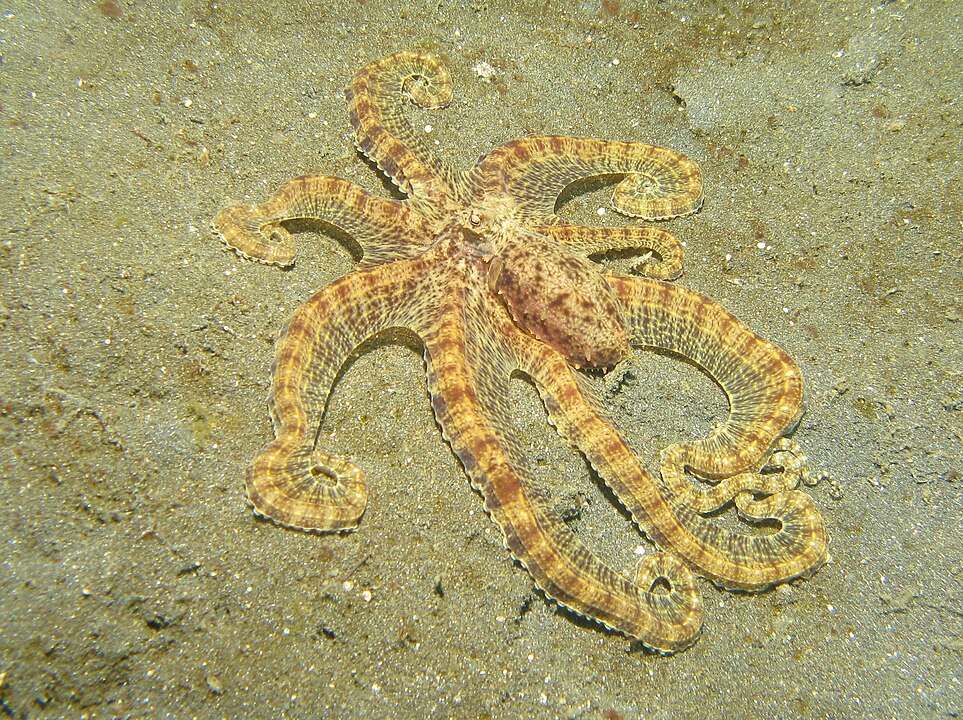
The Mimic Octopus (Thaumoctopus mimicus) is a relatively small octopus, typically reaching a length of about 60 centimeters (24 inches).
The most extraordinary feature of the Mimic Octopus is its ability to mimic the appearance and behaviors of other marine species. It can imitate the shapes, colors, and movements of numerous animals, making it a true master of disguise.
The Mimic Octopus can impersonate various creatures, including lionfish, flatfish, lionfish, and sea snakes. By adjusting its body shape and color patterns, it can convincingly resemble these dangerous or venomous species, deterring potential predators.
Beyond physical imitation, the Mimic Octopus replicates the behavior of the species it mimics. For instance, when it mimics a lionfish, it adopts a hovering posture, waving its arms to simulate the lionfish’s venomous spines.
These octopuses are typically found in the warm waters of the Indo-Pacific region, including the coasts of Indonesia, the Philippines, and Australia. They dwell on sandy and muddy bottoms, often near coral reefs.
Little is known about the reproduction of the Mimic Octopus. They are believed to be semelparous, meaning they reproduce only once in their short lifetime. After laying their eggs, the females guard them diligently.
- Physical Structure: Medium-sized octopus with the ability to change color and shape.
- Unique Characteristics: Can mimic the appearance and behavior of other marine creatures.
Giant Squid
The giant squid (Architeuthis dux) is a fascinating and elusive deep-sea creature that has intrigued scientists and the general public for centuries.
The giant squid is one of the largest known cephalopods, with reported lengths of up to 43 feet (13 meters) for females and slightly smaller for males. It has a long, tubular body, eight long arms, and two much longer tentacles equipped with powerful suckers lined with sharp teeth. The head is relatively small, and the eyes are among the largest in the animal kingdom, measuring up to 10 inches (25 centimeters) in diameter.
Giant squids inhabit the deep ocean, typically found at depths of 1,000 to 2,500 meters. They are believed to have a wide global distribution, with sightings and specimens recorded in various parts of the world’s oceans.
The giant squid is known for its reclusive nature, and until relatively recently, it was primarily a subject of maritime folklore. Encounters with live specimens are extremely rare, and much of what is known about these creatures comes from the examination of dead specimens that have washed ashore or been caught accidentally.
The giant squid is believed to be a carnivorous predator, primarily preying on fish and other squid species. Their sharp, rotating hooks on their tentacles are used to capture and secure prey. Although the giant squid is a formidable predator, it has some natural enemies, such as the sperm whale. It is a subject of debate whether the scars often found on sperm whales’ bodies are the result of battles with giant squids.
The reproduction and life cycle of giant squids are still not well understood. Like other cephalopods, they are thought to have a short lifespan and are semelparous, meaning they reproduce only once in their lifetime.
- Physical Structure: Elusive, massive cephalopod with enormous eyes.
- Unique Characteristics: One of the largest invertebrates with a mysterious lifestyle.
Frilled Shark
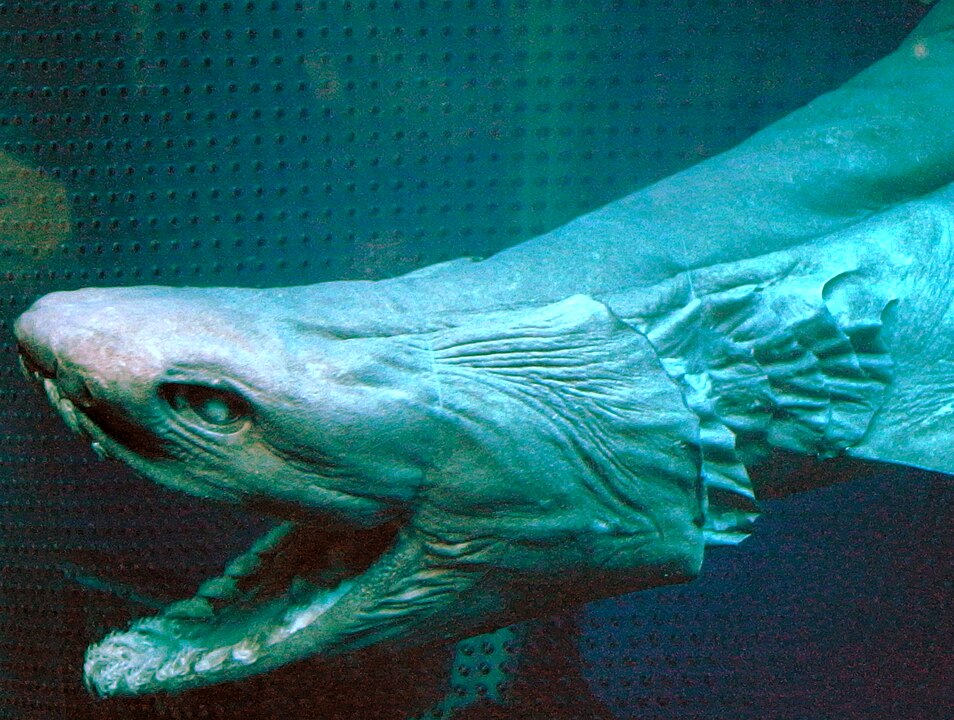
The Frilled Shark is a unique and rarely seen deep-sea creature known for its distinctive appearance and peculiar features.
The Frilled Shark has a long, eel-like body covered in loose, accordion-like skin and a pair of prominent fringed gills on each side of its head, which give it its name. It has a long, serpentine body that can reach lengths of up to 2 meters (6.5 feet).
This species is often referred to as a “living fossil” because it has retained many primitive characteristics that date back to prehistoric times. Frilled Sharks are typically found in the deep waters of the Atlantic and Pacific Oceans, usually at depths ranging from 200 to 1,500 meters (660 to 4,900 feet).
They are opportunistic predators that primarily feed on squid, smaller fish, and other deep-sea creatures. Their long, flexible jaws are lined with rows of needle-like teeth that curve backward, making it difficult for prey to escape.
These sharks have a distinct method of reproduction. Rather than laying eggs, females give birth to live offspring. They have a lower number of offspring compared to many other shark species.
The Frilled Shark exhibits primitive characteristics like its unique gill structure, and it is believed to have changed very little over millions of years of evolution.
- Physical Structure: Primitive-looking shark with a long, eel-like body.
- Unique Characteristics: Has numerous rows of needle-like teeth and is rarely seen by humans.


